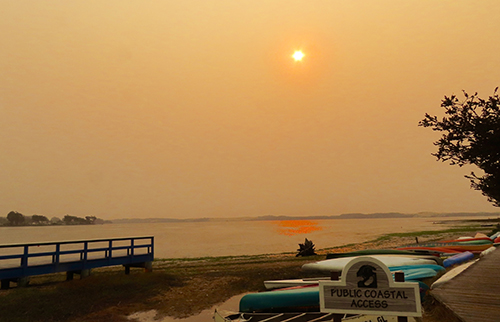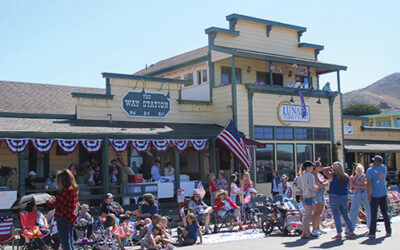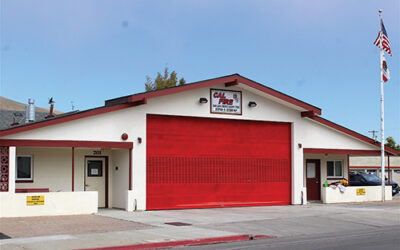The San Luis Obispo County Air Pollution Control District issued an Air Quality Alert in effect across the county beginning on August 18 and continuing through at least August 26 due to hundreds of lightning-stoked, wind-driven fires burning across the state.
Because a pandemic, a heatwave and wildfires aren’t enough, on the afternoon of Aug. 20, Lake Nacimiento was ranked as having the worst air quality in the world with San Miguel in second, according to IQ Air, which operates the world’s largest free real-time air quality information platform. Paso Robles was fifth.
On Aug. 21, the APCD issued a hazardous warning for North County via the social media site Nextdoor.
“Currently, the air quality in Paso Robles, Atascadero, and other North County locations is in the Hazardous range, and it is forecast to remain Hazardous today and to be Unhealthy tomorrow,” the warning stated. “The SLO County APCD does not have the authority to issue mandatory orders, but we strongly recommend that outdoor activities in these areas stop until air quality improves.”
The North Coast faired better but briefly dipped into “unhealthy” and “unhealthy for sensitive” groups including children, elderly, pregnant women and those with existing heart and lung conditions.
By Aug. 23 conditions for the coast were listed as moderate, meaning air quality is acceptable; however, for some pollutants there may be a moderate health concern for a very small number of people. Currently, Aug. 27 and on is rated Good nearly across the county.
The Air Quality Index or AQI is a health-based scale for reporting daily air quality and is an indicator of how clean or polluted the air is, according to the APCD website. The higher the AQI value, the greater the level of pollution and the greater the health concern.
The higher the AQI, the more of the population could begin to experience health effects. The more sensitive you may be, the sooner you may notice adverse effects.
Folks were cautioned to stay indoors as much as possible, close windows, set vents to recirculate and avoid strenuous outdoor activity, if they smelled smoke.
Pairing wildfire smoke with COVID-19 is cause for concern, according to the Centers for Disease Control and Prevention.
“Wildfire smoke can irritate your lungs, cause inflammation, affect your immune system, and make you more prone to lung infections, including SARS-CoV-2, the virus that cause COVID-19,” the CDC website states. “Because of the COVID-19 pandemic, preparing for wildfires might be a little different this year. Know how wildfire smoke can affect you and your loved ones during the COVID-19 pandemic and what you can do to protect yourselves.
It is important to know that facemasks that are used to slow the spread of COVID-19 offer little protection against wildfire smoke. They do not catch small, harmful particles in smoke that can harm your health.
CDC’s tips to create a cleaner air space at home:
• Use a portable air cleaner in one or more rooms. Portable air cleaners work best when run continuously with doors and windows closed.
• If you use a do-it-yourself box fan filtration unit, never leave it unattended.
• During periods of extreme heat, pay attention to temperature forecasts and know how to stay safe in the heat.
• Whenever you can, use air conditioners, heat pumps, fans, and window shades to keep your cleaner air space comfortably cool on hot days.
• If you have a forced air system in your home, you may need to speak with a qualified heating, ventilation, and air conditioning (HVAC) professional about different filters (HEPA or MERV-13 or higher) and settings (“Recirculate” and “On” rather than “Auto”) you can use to reduce indoor smoke.
• Avoid activities that create more indoor and outdoor air pollution, such as frying foods, sweeping, vacuuming, and using gas-powered appliances.
As fire season rages on, Cal Fire recommends people follow their COVID-19 modified Ready, Set, Go program that breaks down the actions needed to be prepared for a fire.
• Be Ready: Create and maintain defensible space and harden your home against flying embers
• Get Set: Prepare your family and home ahead of time for the possibility of having to evacuate. Pack a bag with water, food and medications for you and your pets. Learn about your community’s response plan for each disaster and determine if these plans have been adapted because of COVID-19.
Ask friends or relatives outside your area if you would be able to stay with them, should the need arise. If you do need to evacuate and plan to stay with friends or relatives, ask first if they have symptoms of COVID-19 or have people in their home at higher risk for serious illness. If that is the case, make other arrangements. Check with hotels, motels and campgrounds to learn if they are open.
You should also have to have a communication and emergency plan with your friends and family for how you are going to get out and where you will meet up if separated.
• Be Ready to go: Take the evacuation steps necessary to give your family and home the best chance of surviving a wildfire.
Air quality is changing rapidly, for current & updated conditions visit SLOCleanAir.org.
You can also sign up for AirAware text notifications to receive important updates at SLOCleanAir.org/air-quality-alerts.



